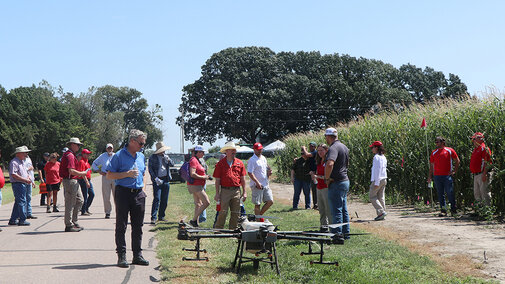Feeding Nebraska communities and feeding the world with climate challenges facing agriculture producers was the underlying topic at this year’s annual Water and Crops Field Day at the University of Nebraska-Lincoln (UNL) West Central Research, Extension and Education Center (WCREEC) in North Platte, Nebraska.
The U.S. Department of Agriculture (USDA) has been working with ag producers for decades on farming practices and, in 2022, began climate-smart agriculture. USDA set three main goals: sustainably increasing productivity and income, increasing adaptation, and reducing greenhouse gas emissions.
“Many of our producers hear about it (climate-smart practices) but don’t know how quickly it’s growing,” WCREEC director Kelly Bruns said.
The field day featured a panel on climate-smart practices, and one of the speakers was Grant Keenan, director of cattle management at Walmart.
“Walmart has a huge commitment to not only the United States but to the world to help promote sustainable practices,” Keenan said. “To ensure nature is here for our kids and our grandkids, right, and we’re able to continue producing that food fiber and shelter that takes care of the world population.”
Walmart has invested in Sustainable Beef LLC, a $325 million beef processing facility in North Platte. It will be served by five feed yards in Nebraska, another four in Kansas, and one in Oklahoma in a 100-mile radius. The facility and feedyards are only a part of the company's Prime Pursuit Supply Chain. Walmart will be able to trace the beef back to its ranches of origin and aid them in regenerative practices, navigating funding and technical assistance.
For cattle to be part of the Prime Pursuit Supply chain, they need to be identified and tracked throughout their life. While the cattle are finished in the feedyards, most are grazed on ranges, cornstalks and cover crops before being moved into area feedlots.
“At first, we really wanted to make sure that we controlled erosion. We didn’t want to have that wind blowing our high-dollar Nebraska dirt around,” said John Schroeder, manager at Darr Feedlot in Cozad. “In a short period of time, we figured out, hey, these cattle can graze this, and there’s a way to pay for this (cover crops) in some years.”
Schroeder has developed different cover crop cocktails with oats, wheat, turnips, radishes and canola. They also used manure to put back some phosphorus and potassium. He said the traditional corn, soybean and alfalfa rotations are working well, but he stressed every area is different.
Cover crops are not just for cattle to graze. In some areas, they can also be a short-season cash crop. Sarah Carlson, with Practical Farmers of Iowa, said regenerative agriculture has a lot of definitions.
“Our vision (of regenerative farming) is to build resilience back into farms and then communities,” she said. “What we really need is more people in our communities, and resilient farms can do this.”
Like others on the climate-smart panel, Practical Farmers of Iowa also work with the farmers and livestock producers to get funding from USDA programs.
More information on cover crops is available on CropWatch.

